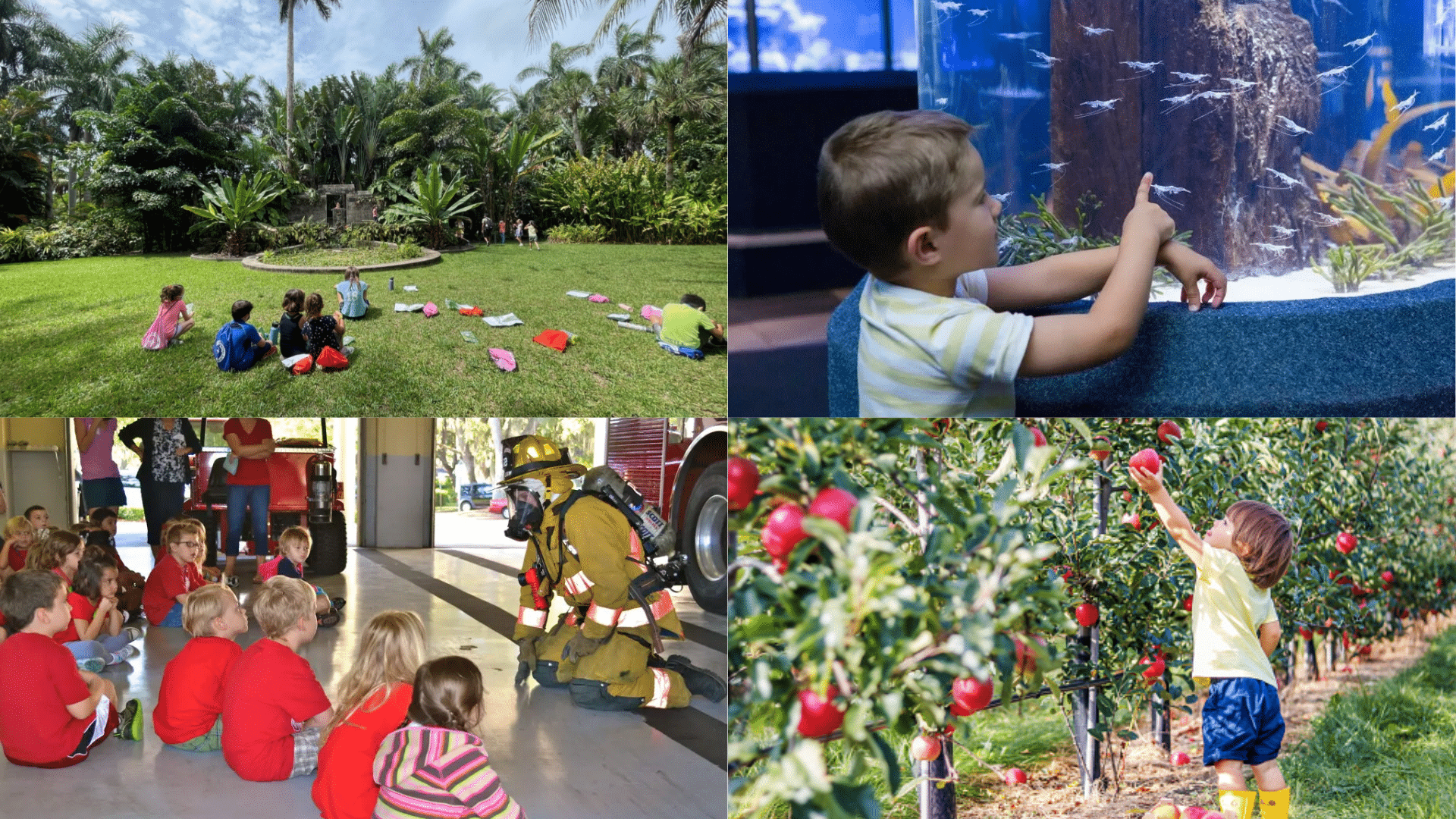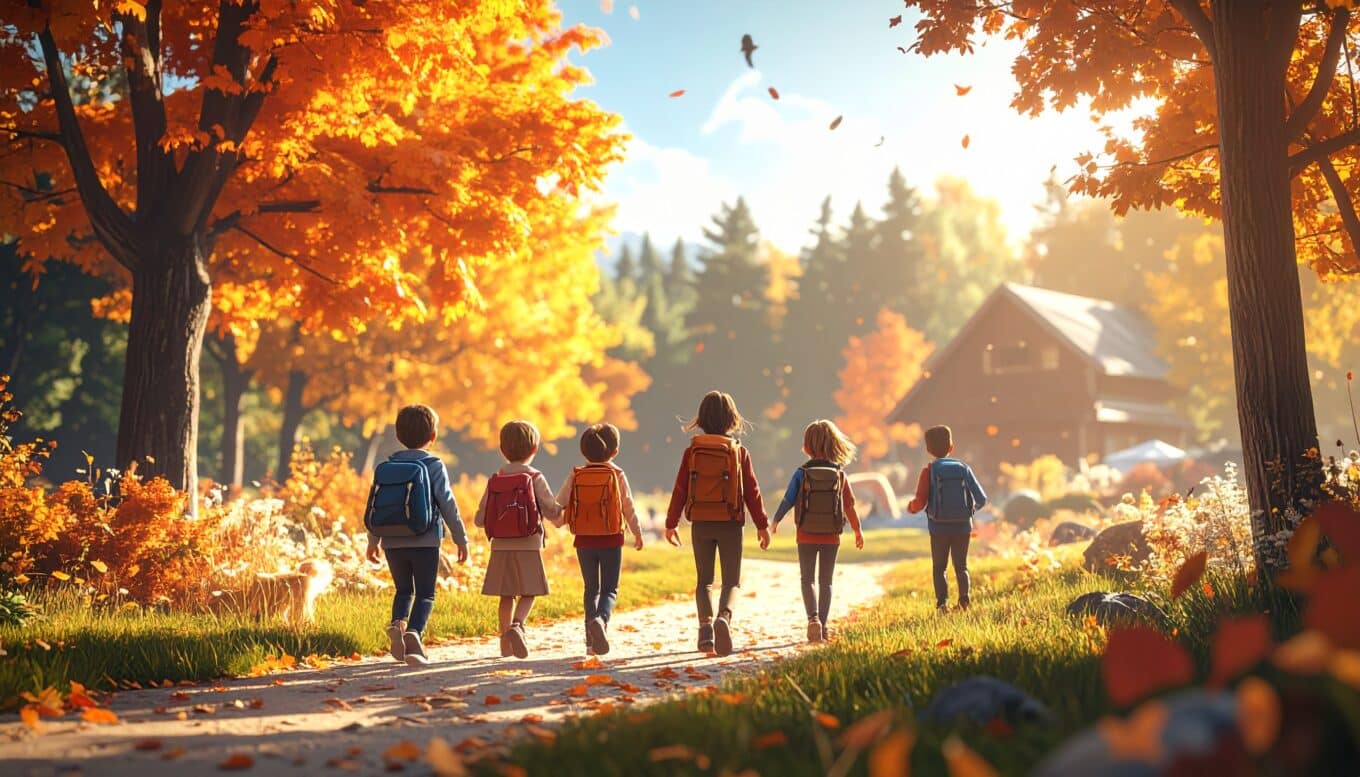Stuck in a homeschool rut? Ready to swap textbooks for real-life learning? Field trips are the magic ticket!
Nothing beats watching your child’s eyes light up when they finally “get it” – all because they touched, saw, or did something hands-on.
We’ve rounded up awesome Homeschool field trip ideas that won’t empty your wallet.
From winter to fall, rain or shine, we’ve got you covered all year! Science buffs, history lovers, art fans, and practical skill-builders will all find something to love.
Seasonal Homeschool Field Trips That Spark Curiosity

Homeschool field trips turn textbook facts into real learning by letting kids see, touch, and do things that make lessons stick better than just reading about them.
1. Apple Orchard Visit
Take a guided tour through an apple orchard where children can learn about pollination, the apple growing process, and different apple varieties. Students can also engage in hands-on apple picking and learn about the science behind tree grafting and seasonal harvesting.
- Best for: Ages 4-12
2. Pumpkin Patch and Farm Tour
A visit to a pumpkin patch provides insights into plant life cycles, soil health, and seasonal crops. Many farms also offer hayrides and talks on sustainable agriculture, making it an engaging way to connect children to where their food comes from.
- Best for: Ages 5-10
3. Autumn Nature Hike
Check out a local forest trail to observe and document seasonal changes in trees, plants, and wildlife. This hike encourages the use of field guides and journals while fostering observational skills and a deeper understanding of ecosystems preparing for winter.
- Best for: Ages 6-14
4. Bird Migration Observation Site
Visit a local wetland or bird sanctuary during peak migration season to witness species on their seasonal journey. Learn about navigation methods used by birds, their habitat needs, and how climate affects migration patterns.
- Best for: Ages 8-16
5. Corn Maze Exploration
Navigate through a corn maze while learning about maize as a historically significant crop. This experience builds problem-solving skills and provides a fun context for discussions on agriculture, engineering, and design.
- Best for: Ages 6-13
6. Cider Mill Tour
Tour a working cider mill to check out how apples are pressed and fermented into cider. Students can observe mechanical processes, learn about pasteurization, and understand the chemistry involved in turning fruit into beverages.
- Best for: Ages 7-14
7. Leaf Pressing Workshop in a Botanical Garden
Collect a variety of fall leaves, learn to identify tree species, and create leaf pressings for botanical study. This creative project blends art and science and allows children to appreciate seasonal biodiversity.
- Best for: Ages 6-12
8. Fall Harvest Festival
Attend a community harvest festival to check out historic farming tools, crafts, and seasonal foods. These festivals often include demonstrations on weaving, canning, and blacksmithing, offering a cultural and historical perspective on autumn traditions
- Best for: Ages 5-11
9. Mushroom Foraging Workshop
Join a mycologist for a safe, guided exploration of local woodlands to identify fungi. Learn to distinguish edible species from poisonous ones while understanding their ecological role in decomposition and symbiosis.
- Best for: Ages 10-17
10. Wildlife Refuge Visit
Check out a protected natural area to observe animals preparing for winter. Learn about conservation efforts, endangered species, and how refuges help maintain biodiversity through responsible stewardship.
- Best for: Ages 7-16
11. Snowflake Science at a Weather Center
Visit a weather observatory or center to study how snowflakes form, how weather is predicted, and the science behind temperature, moisture, and atmospheric pressure. A great introduction to meteorology.
- Best for: Ages 8-14
12. Ice Skating and Physics Day
Check out Newton’s Laws of Motion while gliding across the ice. Students can conduct simple experiments to understand friction, momentum, and balance—all while having fun in a physically engaging environment.
- Best for: Ages 9-15
13. Evergreen Tree Identification Walk
Take a guided nature walk to learn about evergreen trees and how they adapt to cold weather. Children can collect needles, cones, and sketch different species while discussing winter dormancy in deciduous trees.
- Best for: Ages 6-12
14. Visit a Maple Syrup Farm
Observe the tapping of sugar maples and the evaporation process that transforms sap into syrup. This trip combines chemistry, history, and biology, and offers a sweet ending with a syrup tasting.
- Best for: Ages 5-12
15. Indoor Planetarium Visit
Experience the winter night sky indoors with a guided star show. Students will learn about constellations, planetary movements, and myths tied to celestial patterns. An excellent trip for budding astronomers.
- Best for: Ages 6-15
16. Museum of Natural History
Look into the Earth’s history through dinosaur fossils, geology exhibits, and interactive displays on evolution and ancient ecosystems. These indoor exhibits are perfect for expanding on science and history curricula.
- Best for: Ages 7-17
17. Ice Fishing Demonstration
Attend a supervised ice fishing workshop to check out lake ecology and traditional winter survival skills. Learn about the types of fish that thrive in cold water and the role of ice in aquatic life cycles.
- Best for: Ages 10-16
18. Candle Making Workshop
Step into history by making candles using traditional techniques like hand-dipping or molding. Discuss the chemistry behind wax melting and the historical importance of candlelight before electricity.
- Best for: Ages 6-12
19. Indoor Greenhouse Tour
Check out a greenhouse to see how tropical and seasonal plants grow indoors year-round. Learn about humidity control, artificial lighting, and how greenhouses replicate springtime conditions in winter.\
- Best for: Ages 5-13
20. Hot Chocolate Science Lab
Use hot chocolate to check out solubility, temperature, and states of matter. This warm, engaging lab encourages scientific experimentation with everyday ingredients.
- Best for: Ages 6-10
21. Botanical Garden in Bloom
Witness the explosion of color and life in a botanical garden during peak bloom. Students will learn about the anatomy of flowers, pollination processes, and how different plants adapt to the spring growing season.
- Best for: Ages 5-12
22. Butterfly Conservatory Visit
Walk through a living exhibit filled with butterflies and tropical plants. Children can observe the butterfly life cycle firsthand, learn about metamorphosis, and study the important role these insects play in pollination.
- Best for: Ages 5-11
23. Rainwater Collection Demonstration
Participate in a sustainability lesson focused on collecting and reusing rainwater. Learn about the water cycle, conservation techniques, and how rain barrels reduce runoff and support garden irrigation.
- Best for: Ages 8-14
24. Spring Pond Dipping and Amphibian Study
Bring nets and observation jars to a pond to study frogs, tadpoles, and aquatic insects. This field trip introduces ecosystems, amphibian life cycles, and how wetlands support biodiversity.
- Best for: Ages 6-13
25. Visit to a Local Apiary
Check out a working beehive with a beekeeper who explains the hive structure, the queen’s role, and how bees make honey. Children also learn about pollination and why bee populations are critical to agriculture.
- Best for: Ages 7-14
26. Kite Flying and Wind Science Day
Design and fly kites while learning about wind currents, aerodynamics, and the forces of lift and drag. This fun outdoor activity introduces weather science in a playful, hands-on environment.
- Best for: Ages 6-10
27. Garden Center or Nursery Field Trip
Tour a garden nursery to see how flowers and vegetables are grown from seed. Learn about composting, transplanting, and plant care—an ideal introduction to botany and gardening for beginners.
- Best for: Ages 5-11
28. Community Clean-Up and Recycling Center Visit
Organize a litter pick-up followed by a tour of a local recycling facility. This trip teaches environmental responsibility and helps children understand how everyday waste is sorted and reused.
- Best for: Ages 8-16
29. Visit a Lambing Farm
See newborn lambs and other baby animals up close, while learning about animal care, birth cycles, and the agricultural importance of sheep in wool and meat production
- Best for: Ages 5-12
30. Earth Day Eco Fair
Attend a local Earth Day event featuring interactive booths on composting, solar energy, native plants, and more. Students participate in eco-friendly crafts and learn about protecting the planet.
- Best for: Ages 6-14
31. Beach Ecology Exploration
Head to the shoreline to examine tide pools, identify seashells, and learn about coastal erosion. This trip combines marine biology, geology, and conservation in an immersive setting.
- Best for: Ages 7-16
32. Astronomy Night at a Local Observatory
Attend an evening event at an observatory to view planets, stars, and meteor showers. Learn about constellations, light years, and telescopic technology from professional astronomers.
- Best for: Ages 8-17
33. Farmer’s Market Economics Lesson
Visit a farmer’s market to talk with vendors about pricing, supply chains, and local food systems. Students can bring a small budget to buy produce while learning basic math and consumer skills.
- Best for: Ages 6-14
34. Water Treatment Plant Tour
Tour a municipal water facility to see how water is cleaned and delivered to homes. This eye-opening experience explains filtration, sanitation, and the infrastructure that supports everyday living.
- Best for: Ages 9-16
35. Fossil Hunting Expedition
Join a paleontology club or a state park guide to search for real fossils. Learn to identify ancient shells, trilobites, or dinosaur remnants and understand the process of fossilization over time.
- Best for: Ages 8-15
36. Outdoor Art in the Park Day
Bring art supplies to a nature park and let students draw, paint, or sculpt scenes from the natural world. This creative outing encourages observation, expression, and appreciation for outdoor spaces.
- Best for: Ages 5-12
37. Local Fish Hatchery Tour
Check out how fish are bred and raised for conservation or commercial use. Learn about aquatic species, environmental balance, and the importance of hatcheries in restoring wild fish populations.
- Best for: Ages 6-13
38. Canoeing and River Ecology Trip
Take a guided canoe trip along a slow-moving river. Observe aquatic plants, birds, and fish while learning about erosion, watersheds, and how rivers support ecosystems.
- Best for: Ages 9-16
39. Insect Safari in a Meadow
Check out a local field or nature reserve to find and classify bugs. Use magnifying glasses, catch-and-release jars, and insect guides to spark curiosity about entomology and food chains.
- Best for: Ages 6-12
40. Solar Oven Cooking Demo
Build and use solar ovens to cook simple recipes like s’mores or nachos. This hands-on activity introduces children to solar energy, heat transfer, and sustainability.
- Best for: Ages 7-14
41. Outdoor Theater or Shakespeare in the Park
Watch a live performance of a play in an outdoor setting, often free or low-cost. Students experience literature, drama, and history in an interactive format that brings stories to life.
- Best for: Ages 10-16
How to Make the Most of Your Homeschool Field Trips?
Want your homeschool field trips to stick in your child’s memory? The magic happens with a bit of planning! Before your trip, get kids excited by talking about what they’ll see and how it connects to their homeschool lessons.
Make a simple “i wonder…” list where your children write down questions they hope to answer. This builds excitement and gives the trip a clear learning goal!
During your homeschool field trip, turn kids into active learners with fun jobs – they can be photographers, note-takers, map readers, or sketch artists.
These roles keep them engaged instead of just looking around. Bring a homeschool field trip journal where they can write or draw what they notice.
Back at home, the learning continues! Chat about what surprised them or what they liked best. Try a hands-on follow-up project like making a poster, writing a story, or creating a model based on what they saw.
Share photos from your homeschool outing and let kids explain what they learned to friends or family.
Tips for Planning Successful Homeschool Field Trips

Good planning makes homeschool field trips much more helpful for learning. When you plan ahead for travel details, what kids should learn, and what your children need, simple outings become great learning chances.
Here are some helpful tips to make your next homeschool field trip both fun and full of learning:
- Call ahead for homeschool discounts – many places offer special prices for homeschool families or small group visits.
- Look for dedicated homeschool days – museums, science centers, and zoos often hold special homeschool events with extra learning activities.
- Create a field trip scavenger hunt – keep kids interested by making a list of things to find or facts to learn during your homeschool trip.
- Pack field trip snacks and water – help kids stay alert during your homeschool field trip with healthy, easy-to-eat snacks and plenty of water.
- Bring homeschool field trip supplies – a small backpack with a notebook, pencils, and tools like magnifying glasses makes learning better.
- Customize for multiple-age homeschool groups – give older and younger kids different tasks that match their learning levels.
- Choose focused homeschool outings – short, specific field trips often teach more than long, tiring trips with too much to see.
Conclusion
The world is full of amazing Homeschool field trip ideas, just waiting for you and your children to enjoy them!
By mixing these outings into your regular lessons, you’ll create memories while building lasting knowledge.
Start small with local spots, plan ahead with our tips, and watch how these real-world experiences light up your homeschool days.
What homeschool field trip will you try first?




